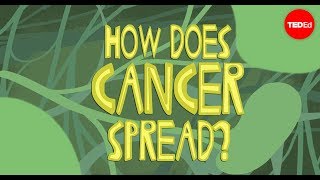The onset of cancer usually begins as a solitary tumor in a specific area of the body.
癌症一般是由身体某处单独的肿瘤演变而来的。
If the tumor is not removed, cancer has the ability to spread to nearby organs,
一旦肿瘤没被及时去除,癌细胞便有能力扩散到附近的器官,
as well as places far away from the origin, such as the brain.
甚至更远,例如大脑。
So how does cancer move to new areas, and why are some organs more likely to get infected than others?
那么到底癌症是怎么转移到新的区域的呢?为什么有些器官受感染的可能性会更大呢?
The process of cancer spreading across the body is known as metastasis.
癌细胞在体内扩散的过程叫做转移。
It begins when cancer cells from an initial tumor invade nearby normal tissue.
当癌细胞离开原发肿瘤部位侵入附近正常的细胞组织,这一过程便开始了。
As the cells proliferate, they spread via one of the three common routes of metastasis:
随着细胞的快速扩散,它们通过三种不同转移路径中的其中一条扩散到体内其他部位:
transcoelomic, lymphatic, or hematogenous spread.
分别是种植性转移,血道转移和淋巴转移。
In transcoelomic spread, malignant cells penetrate the covering surfaces of cavities in our body.
在种植性转移中,恶性细胞穿透体内腔体的表层。
These surfaces are known as peritoneum and serve as walls to segment the body cavity.
这些表层叫做腹膜,它们像墙一样把我们的体腔分隔开来。
Malignant cells in ovarian cancer, for example, spread through peritoneum,
举个例子,卵巢癌的恶性细胞穿过
which connects the ovary to the liver, resulting in metastasis on the liver surface.
连接卵巢和肝脏的腹膜,使得癌症转移到肝脏表层。
Next, cancerous cells invade blood vessels when they undergo hematogenous spread.
接着,癌细胞侵入血管并开始血道转移。
As there are blood vessels almost everywhere in the body, malignant cells utilize this to reach more distant parts of the body.
它们随着这些遍布全身的血管到达身体较远的地方。
Finally, lymphatic spread occurs when the cancer invades the lymph nodes,
最后,癌细胞侵入淋巴结,发生淋巴转移,
and travels to other parts of the body via the lymphatic system.
通过淋巴系统到达身体的其他部位。
As this system drains many parts of the body, it also provides a large network for the cancer.
因为淋巴系统灌溉身体各处,这为癌症转移提供了巨大的网络。
In addition, the lymphatic vessels empty into the blood circulation,
汇入血液的淋巴管让恶性细胞进入血液循环,
allowing the malignant cells to undergo hematogenous spread.
给了它们血道转移的机会。
Once at a new site, the cells once again undergo proliferation, and form small tumors known as micrometastases.
一旦到达新位置,恶性细胞再次快速繁殖并形成小肿瘤,这叫做微转移。
These small tumors then grow into full-fledged tumors, and complete the metastatic process.
这些小肿块最终繁殖成发育完全的肿瘤,完成转移的过程。
Different cancers have been known to have specific sites of metastasis.
现在已经知道,不同类型的癌细胞会向不同的地方转移。
For example, prostate cancer commonly metastasizes to the bone, while colon cancer metastasizes to the liver.
比如说,前列腺癌通常转移到骨骼,而直肠癌一般向肝脏转移。
Various theories have been proposed to explain the migration pattern of malignant cells.
人们给出了许多理论来解释癌细胞的迁移模式。
Of particular interest are two conflicting theories.
其中最引人注意的是两个相互矛盾的理论。
Stephen Paget, an English surgeon, came up with the seed and soil theory of metastasis.
一位英国外科医生,斯蒂芬·派吉特,提出了种子-土壤学说。

The seed and soil theory stated that cancer cells die easily in the wrong microenvironment,
这种理论认为,在错误的微环境下,癌细胞很容易死亡,
hence they only metastasize to a location with similar characteristics.
因此它们只往相似的环境转移。
However, James Ewing, the first professor of pathology at Cornell University, challenged the seed and soil theory,
而詹姆斯·尤因,康奈尔大学的第一位病理学教授,却给出了与土壤学说相反的解释。
and proposed that the site of metastasis was determined by the location of the vascular and lymphatic channels which drain the primary tumor.
他认为,转移的地点是由初期肿瘤进入的血管和淋巴管的位置决定的。
Patients with primary tumors that were drained by vessels leading to the lung would eventually develop lung metastases.
当一个患者初期肿瘤的脉管通向肺部,他的癌细胞便会转移到肺部。
Today, we know that both theories contain valuable truths.
如今,我们知道这两个理论都有一定的道理。
Yet the full stories of metastasis is much more complicated than either of the two proposed theories.
不过癌细胞的转移比它们解释的要复杂太多太多。
Factors like the cancer cell's properties, and the effectiveness of the immune system in eliminating the cancer cells,
许多因素,例如癌细胞的特点和免疫系统去除这些细胞的效力,
also play a role in determining the success of metastasis.
都影响着癌症转移的成功率。
Unfortunately, many questions about metastasis remain unanswered until today.
不幸的是,很多关于转移的问题至今仍是未解之谜。
Understanding the exact mechanism holds an important key to finding a cure for advanced stage cancers.
完全了解该机理对于寻找治疗晚期癌症的方法来说至关重要。
By studying both the genetic and environmental factors, which contribute to successful metastasis,
研究使癌细胞转移成功的基因因素和环境因素
we can pinpoint ways to shut down the process.
可以让我们找到阻止这过程的方法。
The war against cancer is a constant struggle,
与癌症的战斗是持续而艰难的,
and scientists are hard at work developing new methods against metastasis.
科学家们依旧在研究新的抑制转移的方法。
Of recent interest is immunotherapy,
最近备受关注的是免疫疗法:
a modality which involves harnessing the power of the immune system to destroy the migrating cells.
通过加强免疫系统的能力来消灭迁移的细胞。
This can be done in different ways, such as training immune cells to recognize cancerous cells via vaccines.
许多方式都能达到这种效果,例如通过疫苗让免疫细胞识别癌细胞。
The growth and activity of the immune cells can also be stimulated by injecting man-made interleukins,
或者注射人造白介素,来刺激免疫细胞的生长和活动,
chemicals which are usually secreted by the immune cells of the body.
这是一种通常由免疫系统分泌的化学成分。
These two treatments are only the tip of the iceberg.
这两种治疗方式都只是冰山一角。
With the collaborated research efforts of governments, companies and scientists,
在政府,企业和科学家们的共同努力下,
perhaps the process of metastasis will be stopped for good.
也许有一天,我们真的能成功制止癌症转移。











